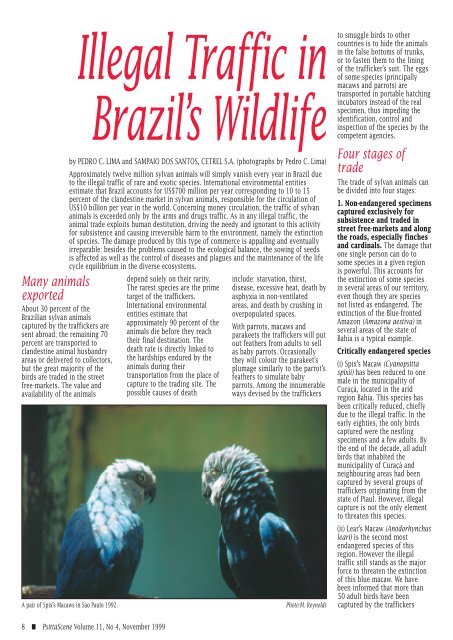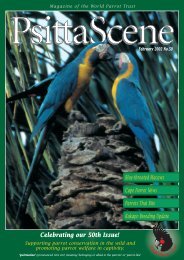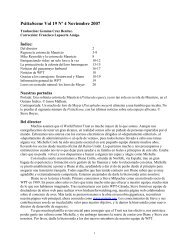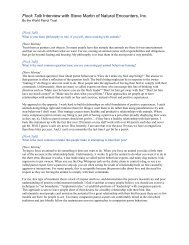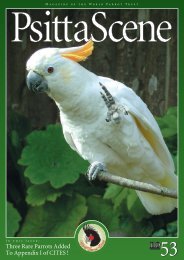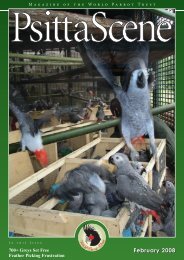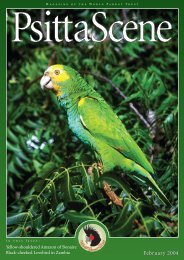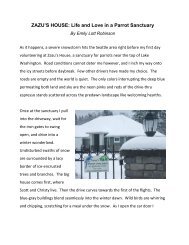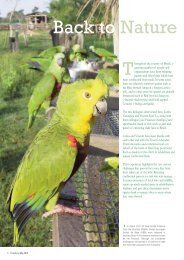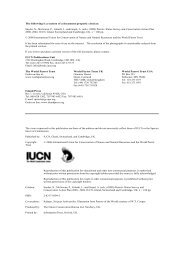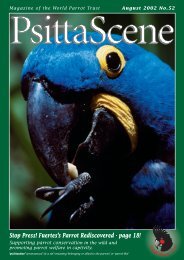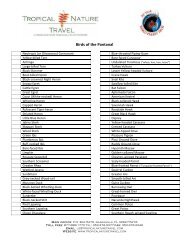Download - World Parrot Trust
Download - World Parrot Trust
Download - World Parrot Trust
You also want an ePaper? Increase the reach of your titles
YUMPU automatically turns print PDFs into web optimized ePapers that Google loves.
Illegal Traffic in<br />
Brazil’s Wildlife<br />
by PEDRO C. LIMA and SAMPAIO DOS SANTOS, CETREL S.A. (photographs by Pedro C. Lima)<br />
Approximately twelve million sylvan animals will simply vanish every year in Brazil due<br />
to the illegal traffic of rare and exotic species. International environmental entities<br />
estimate that Brazil accounts for US$700 million per year corresponding to 10 to 15<br />
percent of the clandestine market in sylvan animals, responsible for the circulation of<br />
US$10 billion per year in the world. Concerning money circulation, the traffic of sylvan<br />
animals is exceeded only by the arms and drugs traffic. As in any illegal traffic, the<br />
animal trade exploits human destitution, driving the needy and ignorant to this activity<br />
for subsistence and causing irreversible harm to the environment, namely the extinction<br />
of species. The damage produced by this type of commerce is appalling and eventually<br />
irreparable: besides the problems caused to the ecological balance, the sowing of seeds<br />
is affected as well as the control of diseases and plagues and the maintenance of the life<br />
cycle equilibrium in the diverse ecosystems.<br />
Many animals<br />
exported<br />
About 30 percent of the<br />
Brazilian sylvan animals<br />
captured by the traffickers are<br />
sent abroad; the remaining 70<br />
percent are transported to<br />
clandestine animal husbandry<br />
areas or delivered to collectors,<br />
but the great majority of the<br />
birds are traded in the street<br />
free-markets. The value and<br />
availability of the animals<br />
A pair of Spix’s Macaws in Sao Paulo 1992.<br />
depend solely on their rarity.<br />
The rarest species are the prime<br />
target of the traffickers.<br />
International environmental<br />
entities estimate that<br />
approximately 90 percent of the<br />
animals die before they reach<br />
their final destination. The<br />
death rate is directly linked to<br />
the hardships endured by the<br />
animals during their<br />
transportation from the place of<br />
capture to the trading site. The<br />
possible causes of death<br />
include: starvation, thirst,<br />
disease, excessive heat, death by<br />
asphyxia in non-ventilated<br />
areas, and death by crushing in<br />
overpopulated spaces.<br />
With parrots, macaws and<br />
parakeets the traffickers will put<br />
out feathers from adults to sell<br />
as baby parrots. Occasionally<br />
they will colour the parakeet’s<br />
plumage similarly to the parrot’s<br />
feathers to simulate baby<br />
parrots. Among the innumerable<br />
ways devised by the traffickers<br />
Photo:M. Reynolds<br />
to smuggle birds to other<br />
countries is to hide the animals<br />
in the false bottoms of trunks,<br />
or to fasten them to the lining<br />
of the trafficker’s suit. The eggs<br />
of some species (principally<br />
macaws and parrots) are<br />
transported in portable hatching<br />
incubators instead of the real<br />
specimen, thus impeding the<br />
identification, control and<br />
inspection of the species by the<br />
competent agencies.<br />
Four stages of<br />
trade<br />
The trade of sylvan animals can<br />
be divided into four stages:<br />
1. Non-endangered specimens<br />
captured exclusively for<br />
subsistence and traded in<br />
street free-markets and along<br />
the roads, especially finches<br />
and cardinals. The damage that<br />
one single person can do to<br />
some species in a given region<br />
is powerful. This accounts for<br />
the extinction of some species<br />
in several areas of our territory,<br />
even though they are species<br />
not listed as endangered. The<br />
extinction of the Blue-fronted<br />
Amazon (Amazona aestiva) in<br />
several areas of the state of<br />
Bahia is a typical example.<br />
Critically endangered species<br />
(i) Spix’s Macaw (Cyanopsitta<br />
spixii) has been reduced to one<br />
male in the municipality of<br />
Curaçá, located in the arid<br />
region Bahia. This species has<br />
been critically reduced, chiefly<br />
due to the illegal traffic. In the<br />
early eighties, the only birds<br />
captured were the nestling<br />
specimens and a few adults. By<br />
the end of the decade, all adult<br />
birds that inhabited the<br />
municipality of Curaçá and<br />
neighbouring areas had been<br />
captured by several groups of<br />
traffickers originating from the<br />
state of PiauÌ. However, illegal<br />
capture is not the only element<br />
to threaten this species.<br />
(ii) Lear’s Macaw (Anodorhynchus<br />
leari) is the second most<br />
endangered species of this<br />
region. However the illegal<br />
traffic still stands as the major<br />
force to threaten the extinction<br />
of this blue macaw. We have<br />
been informed that more than<br />
50 adult birds have been<br />
captured by the traffickers<br />
8 ■ PsittaScene Volume 11, No 4, November 1999


